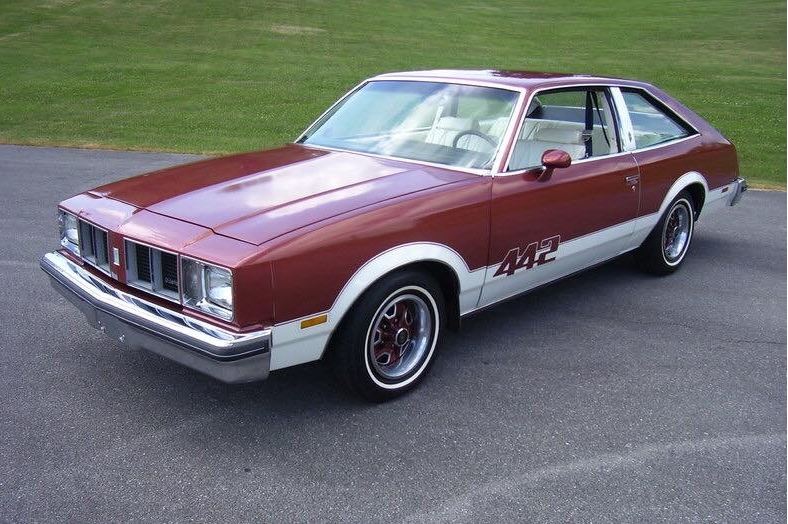During the early 1980s, Oldsmobile juggled some nameplates around, solving old problems and creating new ones. Their redesigned intermediate Cutlass from 1978 fared well during the downsized era. Fears of the buyer rejecting a smaller Cutlass proved to be unfounded. In Europe, there was no such stigma attached to a car just on size alone. GM’s designers liked European cars for their outre ideas and there was a brief European influence on 1970s A bodies.
GM experimented with the Colonnade era cars, but for the most part it amounted to slightly better suspensions and a whole lot of European flags on the front fenders as trim. They weren’t really suited for international roads and gas mileage was a sad joke. However the 1978 redesign was different. Smaller, with more efficient engines and some inherent solid lines presented opportunities for tweaking. The actual 1978 model needed more imaginative front and rear styling to make it nicer, but the basic outline was good. While the 442 still existed it was a handling and decal package victimized by emissions rule tightening. In 1979 Olds brought back the Hurst/Olds from the grave with a fresh new take on the legacy. There was even a 1980 H/O W30 car; sort of. It’s tricky; grab a coffee and sit down. This will take a while.
Behind the Scenes Drama with Hurst Olds:
It wasn’t smooth sailing though and it almost failed. Olds sent Hurst a Cutlass Calais in black for modifications into a proposed H/O coupe. Hurst got the car in October, 1977 and prepared a black car with gold side stripes, unique grille, front air dam, alloy wheels, dual gate shifter and an extended sail panel roof. By August 1978, Olds informed Hurst they weren’t using the dual gate shifter. The wanted to use their own ratchet shifter. This didn’t sit well with Hurst and they sent a letter telling Olds, Hurst would not ship decals and emblems for installation on the W30 car. By late September, talks died. Unfortunately for both firms, press releases went out to magazines and the October Motor Trend issue did a big puff piece on the car.
The 1980 Almost H/O:
Calmer heads prevailed and the project resumed, but with the car being built completely at Lansing using Hurst supplied emblems and shifters.
Olds made a limited edition run of 2,499 of these high end cars. Of that total, 1,165 of them were white and gold. They were based on the Calais trim line which was a bucket seat and console interior car. The only paint choices were black or white with gold stripes. The package included alloy sport wheels, raised white letter tires, sport console with Hurst Dual Gate shifter, power disc brakes, handling package, contoured reclining bucket seats and full gauge instrumentation. In addition you could also order the hatch panel roof option and just 536 Hurst Olds came with it that year. The engine was a 350 powered Rocket V8. This warranted Olds calling it the H/O W30. There was no cold air induction however. While exterior colours were limited to black or white with gold accents, the interiors were more flexible. Having that third colour allowed more combos to be used. As for 1980 W30 cars, the frosty relations between the two companies meant none of the 1980 W30 cars got Hurst dual gate shifters. Olds went nuts and produced a $1,255 442 package that included special grille, stripes, rallye suspension, radial tires, a unique interior and modified 350 V8 gas powered engine. 538 of them were black and gold, the white and gold cars were very scarce with just 348 made. We’re talking pretty rare cars here. In a way, they’re continuation models, but with five rectangle 1980 grilles and trim and diecast 442 sail panel badges instead of H/O badges. The next proper H/O car was a 1983 model year. Yes, for 1980, Olds used the W30 option term to describe a loaded Hurst/Olds Cutlass Calais while also selling a 442 trim package. Talk about confusion.
Production of 1979 442 Cutlasses was small. They’re about as rare as the Hurst Olds. There were just 8,399 Cutlass Salon two-door fastback coupes and a bare 3,617 Cutlass Salon brougham fastback coupes made in 1979. Given such low numbers there can’t be many 442 cars around. It seemed like a strange idea to showcase a traditional muscle car package with an exotic body style reminisent of the Hooper bodied Cadillac Seville from the same year. Olds was probably hoping to nab some of the high-end cachet factor with that design. Sales never matched the hoopla and the Lansing Boys quickly reverted to the Calais body for future performance editions. Someone forgot that muscle car owners are traditional in their tastes. The public had to remind manufacturers a few times during the 1980s like when Ford thought of turning a Mazda into a Mustang.
Calais Steps Up to the Plate:
By 1981 the 442 model vanished along with Hurst/Olds. It may have looked grim on the surface, but there was hope. The Calais model still existed and that wound up being the saviour of Lansing for image purposes. By 1981 Olds had three Cutlass models, the sporting Calais, the upscale Supreme and the basic Cutlass. The fastback Salon was dropped along with the brougham. The car had a clever facelift with curves on the leading edges of grille and hood filler panel. The grilles were on hinges which allowed partial rotation inwards for protection in minor accidents. It was an idea borrowed from the 1973 full-sized Olds. Only 4,105 Calais were made that year while the more posh Supreme brougham had 93,855 sales and the one step below Supreme coupe had a staggering 187,875 sales. Any marketing whiz could see what to do next. Juice sales by adding the best features of the Supreme brougham to a Calais and badge it as a hot rod.
Oldsmobile didn’t do that until 1983. The Division suffered a major drop in sales for 1982, forcing them to consider filling the gaps in their product line. They did some emergency fiddling by adding the Y78 Salon option to the 1982 Cutlass Calais model that year. The sales rose to 17,109, but the recession was so hard it was like putting a bandaid on a machete gash. Things got better in 1983 when Olds returned to the idea of making the Calais a real performance package. We’ll cover that in a future article.
Enjoyed the article or have questions? Write to pa67smith @yahoo.com.

